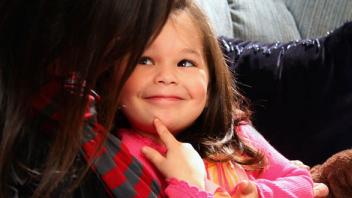Children can learn that spoken sentences are made up of words and that words are made up of separate sounds.
They can learn that many words can be separated into syllables (for example, /bu/ /cket/ in bucket and /te/ /le/ /phone/ in telephone). Children can also learn that syllables can be separated into sounds (for example, /b/ /u/ and /k/ /e/ /t/ in bucket) and that words can be separated into sounds (for example, /k/ /a/ /t/ in cat).
Later children will be able to connect the sounds in spoken words with the letters in printed words. Most children will benefit from much practice at playing with the sounds of words.
Beginning and ending sounds
- Help your children learn to identify the sounds at the beginning of words (for example, the sound /t/ in top and the sound /b/ in big). Practice with other words and their beginning sounds.
- Help your children learn to separate sounds at the beginning of words (for example, ask what would be left if you took the /r/ sound out of “run” or if you took the /s/ sound away from sat). Continue with other sounds and words.
- Help your children learn to blend the separated sounds of spoken words. Ask your children to tell you what they would have if they put these sounds together: /m/ and /other/ (mother); /k/ and /andy/ (candy); and /s/, /a/, and /t/ (sat). Continue with other words.
- Ask your children which one of these words – bag, cat, bike, boat – starts with a different sound. Practice with other words.
- Say four words that have the same beginning sound. Ask your children to listen and say the beginning sound (for example, the beginning sound is /h/ in hat, hop, hit, hand).
- Say four words that have the same ending sound. Ask your children to listen and tell you what the ending sound is (for example, the ending sound is /p/ in stop, pop, cop, and top).
- Have your children take an imaginary shopping trip. Give each child a paper sack and an old magazine. Point out pictures of objects in their magazines. If your children can tell you what sounds the names of the objects begin with, let them cut out the pictures and put them into their sack. After the shopping trip is over, look at the pictures with your children and let them say the beginning sound of each object’s name.
Rhyming
- Teach your children to pick out rhyming words. Have your children find household objects which have names that rhyme, such as bread and thread.
- Sing songs and read rhyming books with your children.
- Using old magazines, have your children look for pictures that have names that rhyme. For example, choose a picture of a cat and find other pictures with names that rhyme with cat such as hat, mat, and bat. Have your children cut out the pictures and paste them on a sheet of paper. Have them say all the rhyming words on their sheet of paper.
Sentences, words, and syllables
- Say a sentence and have your children clap out the number of words in the sentence (for example, they will clap five times after hearing the sentence, “The boy ran very fast,” and only four times after hearing “The boy ran fast”).
- Choose a word that is made up of two words (for example, sunshine is made up of sun and shine). Tell your children that you are going to say the word and then you will say it again, leaving off part of the word (for example, say sunshine and then say shine). Ask what part of the word was left off. (The sun was left off.) Practice with many different two-part words.
- Say a word and have your children clap out the number of syllables (for example, the word personal has three syllables: per – son – al. Your children will clap three times). You may want to use a dictionary for help with syllables.
Citation
Adapted from: Beginning Reading Instruction: Practical Ideas for Parents. Texas Education Agency.
Reprints
You are welcome to print copies for non-commercial use, or a limited number for educational purposes, as long as credit is given to Reading Rockets and the author(s). For commercial use, please contact the author or publisher listed.
